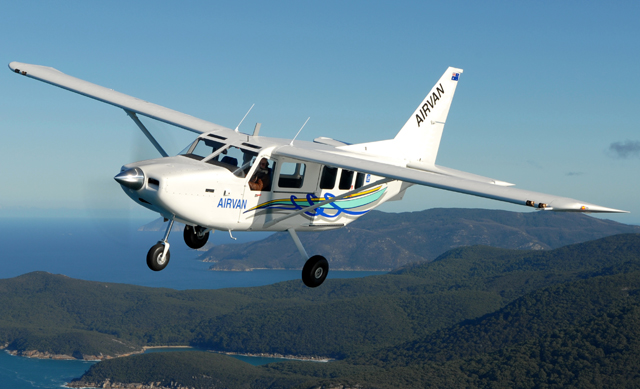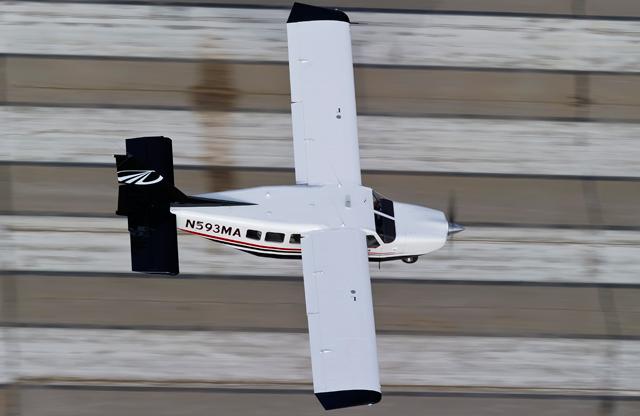With a manufacturing base in Australia, a marketing and assembly operation in the USA, a growing global sales and support network and ownership by an Indian conglomerate, Mahindra Aerospace is truly a global company.
Mahindra, formerly Gippsland Aeronautics (and later GippsAero), was once a small, Australian niche manufacturer of utility aircraft, having started out as an aircraft maintenance and modification business. But since its acquisition by Indian automotive and information technology group Mahindra in 2009, the company, now Mahindra Aerospace, has been spreading its wings.
As a small, Australian company, Gippsland was successful in getting its flagship product, the Airvan 8 (formerly the GA8 Airvan) into international markets. The high-wing, eight-seat, piston-powered utility aircraft, which was certificated by the Australian Civil Aviation Safety Authority in 2000, is now operating in more than 34 countries, in roles ranging from air taxi, freight, tourism, missionary work, skydiving and law enforcement, thanks to its low operating costs and versatility. Numerous versions and upgrades have followed, including a turbocharged version.
In early January, Mahindra was assembling Airvan 8 number 209 at its Latrobe Valley, Victoria, manufacturing facility, which has a production capacity of two to three aircraft per month. Following its manufacture in Australia, the aircraft, destined for North American customer Spectra Energy, was due to be disassembled and shipped to the USA, where it will be reassembled by Soloy Aviation Solutions. Soloy was appointed in 2012 to conduct assembly of the Airvan 8 for the North American market in an effort to boost sales of the type there. The arrangement appears to be paying off, with Mahindra gaining a foothold in a market where 43 are now operation. Jon Dauplaise, Mahindra’s US-based vice-president global sales and marketing says Soloy assembles the aircraft whenever it makes “geographical sense”.

Mahindra's flagship product, the eight-seat piston-powered Airvan 8, is now operating in more than 34 countries
Mahindra
Recent changes in regulations regarding seating for piston-powered aircraft by the Indian government mean the manufacturer will soon be able to sell its aircraft there, with Mahindra having “aggressive plans in India”, says Dauplaise.
In addition, certification of the type was recently received in China – another country where Mahindra is “very optimistic” about sales.
Over the past couple of years, Mahindra has been focused on establishing a global sales and support network for its aircraft and this effort is set to continue. “Our focus this year and next is on building an eco-system and support network. You don’t want to just pump aircraft into a market without support,” says Dauplaise. “You have to get sales first and once you’ve established a foothold in the market, put the support in place. It’s very hard to support from Australia,” he adds.
Following the appointment of dealers in Europe, Asia-Pacific, Africa and North America, South America and particularly Brazil are the next focus, says Dauplaise. The Airvan 8 received Brazilian certification last October and the rugged environment, makes the country an ideal market for the type.
Further development of the Airvan 8 is under way, with the aircraft “by no means stagnant”, according to Dauplaise. For the cold weather market, in Alaska, for example, where the Airvan 8 has secured recent sales, a version with retractable skis will be available early this year. An intelligence, surveillance and reconnaissance version, developed with Summit Aviation, is also planned.
Development also continues of a float version, which the manufacturer has been working on with US float specialist Wipaire since 2011. Dauplaise says he prefers not to put a timeline on completion of that programme, which has been held up by the northern hemisphere winter, as frozen lakes have halted the flight-test programme.
Last year, Mahindra launched an executive interior for the Airvan 8 as an option in a bid to compete with its primary competitor, the Cessna 206 in the private owner-flown market. The Airvan 8 has always performed strongly in the utility market but has underperformed in the private owner market and the customised interior, which would be installed in the USA, is an attempt to address this, he says.
When Mahindra first acquired Gippsland, it had ambitions of growing the Airvan family with two more members – the Airvan 10 and Airvan 18 (the former Nomad) within two years. While that ambition has not been fulfilled, work on new family members continues, with certification of the Airvan 10 progressing, according to Dauplaise.
The Airvan 10 is a stretch of the Airvan 8, featuring 10 seats and is based on the same concept as its eight-seat cousin, namely simplicity at low operating costs. The programme was launched in 2011, with first flight in May 2012 and originally aiming for 2013 certification. The aircraft is still in development and “well on track”, says Dauplaise, adding that the aircraft is “stable and predictable”, but declining to put a date on certification. “The certification process is lengthy,” he says, conceding that the programme is not on its original schedule. The aircraft will receive Australian certification first, but the manufacturer is trying to do as much work as possible for US Federal Aviation Administration certification as well.

A 10-seat version of the Airvan is planned
Mahindra
Dauplaise says there is “tremendous interest” in the aircraft, especially in North America. As a result, the manufacturer has high hopes of the Airvan 10 exceeding the success of the Airvan 8, with 30-40 aircraft deliveries a year forecast. Just as GippsAero/Mahindra did with the Airvan 8, the Airvan 10 will undergo constant development.
The Airvan 10, along with the Airvan 8, will be flying and on display in the static park at this year’s Australian International Airshow to be held at Avalon Airport, Victoria, from 24 February-1 March.
Mahindra is less forthcoming about the former Nomad programme. GippsAero purchased the type certificate for the former Australian government aircraft from Boeing Australia in May 2008, with the intention of upgrading it with new engines, propellers, empennage and a glass cockpit and relaunching it as the 18-seat GA18. When Mahindra purchased the Australian manufacturer, it confirmed its intention to continue with the programme, planning to bring it to market within two years. The manufacturer has since focused development on the Airvan 10. Of the Airvan 18, Dauplaise says: “It has not been shelved per se, but until the Airvan 10 is certificated we are not working on it.” The manufacturer is still evaluating the Airvan 18 and will conduct proper research once the Airvan 10 programme is completed, he says.
Since becoming foreign owned, questions over whether Australian production will continue have hung over Mahindra Aerospace. A restructure of the Australian operation in 2013, which involved the loss of 39 jobs due to a tough utility aircraft market and strong Australian dollar, intensified concerns that work would be transferred to India. The parent has a growing component manufacturing facility in Bangalore.
The company employs 152 at its Australian facility, with a further 26 employed at Aerostaff in Australia, which was acquired at the same time as GippsAero, and four employed in North America. The market has picked up since the restructure and “things are generally better”, according to Dauplaise. Mahindra has “every intention” that the Airvan 10 will roll down the production line in Australia, he says.
Mahindra is a $16 billion global company and “fully intends to maintain and grow the [aerospace] business”.
BOX
Two of Australia’s other niche manufacturers, Jabiru Aircraft and Seabird Aviation had their own developments in 2014.
In December, Australia’s Civil Aviation Safety Authority imposed precautionary operating restrictions on aircraft equipped with Jabiru Aircraft engines because of reliability issues. Privately-owned Bundaberg, Queensland-based Jabiru manufactures four-cylinder 2,200cc and six-cylinder 3,300cc engines, which are fitted to about 1,300 aircraft operating in Australia, including its own light aircraft.
The CASA move followed “a high number of Jabiru engine failures and power loss incidents, some of which resulted in aircraft forced landings”, according to CASA. The regulator says more than 45 Jabiru engine failures or in-flight engine incidents were reported in 2014. Problems include failures of through bolts, flywheel bolts and valve train assemblies, as well as cylinder cracking, with problems encountered primarily by aircraft used for flying training.
CASA says it is working with Jabiru and other stakeholders to identify the causes and to implement appropriate solutions, investigating design and mechanical issues, how aircraft are flown and maintenance-related issues. The regulator imposed the limitations in late December, having released a draft consultation in November, to which it received 630 responses.
The original proposal was modified, but the limitations, which remain in place up to June, restrict flights to day time under visual flight rules, require aircraft to be flown so they can at all times glide clear of a populous area, require passengers and trainee pilots flying solo to sign a statement saying they are aware of and accept the risk of an engine failure and require trainee pilots to have recently and successfully completed engine failure exercises before solo flights.
Jabiru has disputed CASA’s findings and says the action has “severely damaged” its reputation internationally. “It will change recreational aviation in Australia long-term. It is a clear sign that CASA now wants to take control of this segment of aviation. This extra oversight by CASA has already deterred many from the recreational aviation market,” says Sue Woods, business manager.
The industry body representing Australia’s ultralight, recreational and light sport aircraft sectors, Recreational Aviation Australia (RA-Aus) expressed “serious concern” and accused CASA of “misconduct” over the issue.
“While we concede that the actions taken are in relation to the reliability of Jabiru engines and agree that said engines display markedly lower reliability figures than competitor engines, it is our belief that irreparable damage has been caused to the already fragile Australian aviation industry as a result of the regulator’s actions,” RA-Aus says.
The manufacturer says data provided to CASA indicates 40 engine incidents in 2014, including 12 stoppages in-flight which required forced landings, with no serious injuries or fatalities, out of nearly 41,800 flying hours and 92,700 flights in Australia.
Woods says Jabiru will run more training courses for owners and maintainers to try to lift the standard of maintenance and is continuing research and development to make the engines more robust.
Meanwhile, former Australian manufacturer Seabird Aviation was acquired last year by Seeker America, subsidiary of US aerospace company CSI Aviation. The former Hervey Bay, Queensland manufacturer had spent 30-plus years developing and establishing a global market for its fixed-wing Seeker patrol and surveillance aircraft. The aircraft was manufactured in Hervey Bay, with licensed production in Jordan at Seabird Aviation Jordan (which has since closed), and sold 12 aircraft in Australia, Azerbaijan, Iraq, Jordan, the United Arab Emirates, the USA, South Africa and Tanzania, under founder Don Adams and then under his son, Peter.
The family company spent decades trying to grow the business, but sold it last year, recognising that new investment was needed to make it successful. At the time of the purchase, Albuquerque-based Seeker America said production would eventually move to North America. Seeker Aircraft America president and chief executive David Pohlman now says: “Manufacture of the Seeker aircraft will be done in Australia for the immediate future. When demand exceeds the capacity of the Australian facility, we will grow capacity elsewhere. In this scenario, Seabird will produce parts and major sub-assemblies for the aircraft at the facility in Hervey Bay.”
The company will focus sales activities on North and Latin America, he adds.
Source: Flight International























